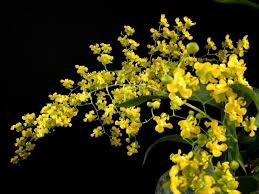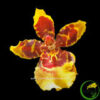# Comparing Drought Tolerance in Oncidium Orchids with Other Orchid Species

Orchids are a diverse and fascinating family of flowering plants, encompassing a wide range of species that vary significantly in their environmental requirements. Among these, Oncidium orchids, commonly known as “Dancing Lady Orchids,” are popular for their striking floral displays and unique characteristics. One crucial aspect that differentiates various orchid species is their ability to tolerate drought. This article explores the drought tolerance of Oncidium orchids compared to other orchid species, delving into their adaptations, care requirements, and practical implications for growers.
## 1. Understanding Orchid Drought Tolerance
### 1.1 What is Drought Tolerance?
Drought tolerance refers to a plant’s ability to withstand periods of water scarcity without suffering irreversible damage or death. This ability can be influenced by various factors, including root structure, leaf morphology, and overall physiology. For orchids, drought tolerance is crucial as it directly impacts their survival in environments where water availability fluctuates.
### 1.2 Importance of Drought Tolerance in Orchids
Drought tolerance is essential for orchid survival in various habitats, especially in regions characterized by seasonal rainfall and extended dry periods. Understanding the drought tolerance of specific orchid species aids in proper care, cultivation practices, and conservation efforts.
## 2. Oncidium Orchids: An Overview
### 2.1 Characteristics of Oncidium Orchids
Oncidium orchids are renowned for their:
– **Diverse Morphology**: They exhibit a wide range of flower shapes and colors, making them a favorite among orchid enthusiasts.
– **Growing Habitats**: Oncidium species can be found in various environments, from tropical rainforests to subtropical regions, demonstrating adaptability to different moisture levels.
### 2.2 Drought Tolerance in Oncidium Orchids
Oncidium orchids generally display moderate drought tolerance, which allows them to survive short periods of water scarcity. Some key adaptations contributing to their drought tolerance include:
– **Root Structure**: Oncidium orchids possess fibrous roots that are efficient in absorbing water from the environment, allowing them to utilize available moisture effectively.
– **Leaf Adaptations**: The leaves of Oncidium orchids often have a thicker cuticle, reducing water loss through transpiration.
## 3. Comparison with Other Orchid Species
### 3.1 Cattleya Orchids
Cattleya orchids are known for their large, showy flowers and are often considered the “queen of orchids.”
#### 3.1.1 Drought Tolerance
– **High Tolerance**: Cattleya orchids exhibit higher drought tolerance compared to Oncidium. They can endure extended periods without water, thanks to their pseudobulbs, which store water.
– **Root Adaptation**: Their thickened roots are designed to store moisture and withstand dry conditions, enabling them to thrive in environments with intermittent rainfall.
### 3.2 Phalaenopsis Orchids
Phalaenopsis, or “moth orchids,” are among the most popular orchids for indoor cultivation due to their long-lasting flowers and ease of care.
#### 3.2.1 Drought Tolerance
– **Low to Moderate Tolerance**: Phalaenopsis orchids are less drought-tolerant than both Oncidium and Cattleya. They prefer consistent moisture and can suffer quickly from dehydration.
– **Water Requirements**: These orchids thrive in humid conditions and require regular watering to maintain their health, making them less suitable for drought-prone environments.
### 3.3 Dendrobium Orchids
Dendrobium orchids are another diverse group known for their unique flower structures and seasonal blooming patterns.
#### 3.3.1 Drought Tolerance
– **Moderate Tolerance**: Some Dendrobium species exhibit moderate drought tolerance, similar to Oncidium. They can withstand short dry spells, but prolonged drought can lead to stress and reduced flowering.
– **Adaptations**: Many Dendrobium species have adapted to seasonal rainfall patterns, where they can utilize available moisture efficiently during wet periods.
### 3.4 Vanda Orchids
Vanda orchids are famous for their vibrant colors and large blooms, often grown in hanging baskets to allow their roots to air out.
#### 3.4.1 Drought Tolerance
– **Low Tolerance**: Vanda orchids generally have low drought tolerance and require consistent humidity and moisture. They are more susceptible to drying out than Oncidium.
– **Care Needs**: Vandas thrive in environments with high humidity and regular watering, making them less suitable for arid conditions.
## 4. Factors Influencing Drought Tolerance in Orchids
### 4.1 Environmental Adaptations
Orchids have developed various adaptations to cope with their native environments, which can significantly influence their drought tolerance:
– **Root Structure**: As mentioned, root systems play a vital role in moisture absorption. Species with fleshy roots tend to store more water, enhancing their drought resilience.
– **Leaf Morphology**: Leaf thickness and surface area contribute to transpiration rates. Species with thicker leaves are often better at conserving water.
### 4.2 Geographic Distribution
The geographic distribution of orchids also affects their drought tolerance:
– **Tropical vs. Temperate**: Orchids from tropical regions may have different drought tolerance levels compared to those from temperate zones. For instance, orchids adapted to the dry seasons of tropical areas may show enhanced drought resistance.
– **Elevation**: Orchids growing at higher elevations may experience less humidity, which can drive adaptations that enhance drought tolerance.
## 5. Practical Considerations for Cultivating Drought-Tolerant Orchids
### 5.1 Choosing the Right Species
When selecting orchids for drought-prone areas or conditions, consider the following:
– **Assessing Environment**: Evaluate the local climate and growing conditions. Opt for orchids known for their drought tolerance, such as Cattleya or specific Oncidium hybrids.
– **Variety Selection**: Research specific varieties known for enhanced drought resistance within each orchid type.
### 5.2 Cultivation Practices
To cultivate drought-tolerant orchids successfully, implement these practices:
– **Potting Medium**: Use well-draining potting mixes to prevent root rot. A blend of bark, perlite, and charcoal can enhance drainage and aeration.
– **Watering Schedule**: Establish a watering schedule based on the specific needs of the orchid species. For drought-tolerant orchids, allow the medium to dry out between waterings.
### 5.3 Monitoring Conditions
Regular monitoring of environmental conditions is crucial:
– **Humidity Levels**: Maintain appropriate humidity levels, particularly for species with lower drought tolerance. Using humidity trays or misters can help.
– **Light Requirements**: Ensure that orchids receive adequate light without becoming stressed. Adjust light exposure based on the species’ preferences.
## 6. Case Studies: Successful Cultivation of Drought-Tolerant Orchids
### 6.1 Cultivation in Arid Regions
In arid regions, growers have successfully cultivated drought-tolerant orchids by implementing innovative practices:
– **Use of Greenhouses**: Greenhouses with controlled environments can help manage humidity and temperature, supporting the growth of drought-tolerant orchids like Cattleya and Oncidium.
– **Hydroponics**: Some growers experiment with hydroponic systems, allowing for precise control over nutrient and moisture levels, promoting healthy growth in drought-prone areas.
### 6.2 Home Gardeners’ Success Stories
Home gardeners have found success with drought-tolerant orchids by adapting care practices:
– **Grouping Orchids**: Grouping orchids with similar water and light needs can create a microenvironment that supports healthy growth.
– **Water-Saving Techniques**: Utilizing water-saving techniques, such as drip irrigation or self-watering pots, helps maintain optimal moisture levels for drought-tolerant species.
## 7. Conclusion
Understanding the drought tolerance of Oncidium orchids compared to other orchid species is essential for successful cultivation and care. While Oncidium orchids exhibit moderate drought tolerance, other species like Cattleya display higher resilience, while Phalaenopsis and Vanda require more consistent moisture. By considering environmental adaptations, geographic distributions, and proper cultivation practices, growers can make informed choices about the best orchid species for their specific conditions. Ultimately, the ability to select and care for drought-tolerant orchids not only enhances their survival but also contributes to the beauty and diversity of our orchid collections. Whether for personal enjoyment or commercial purposes, understanding the nuances of drought tolerance in orchids is key to successful cultivation and appreciation of these extraordinary plants.

